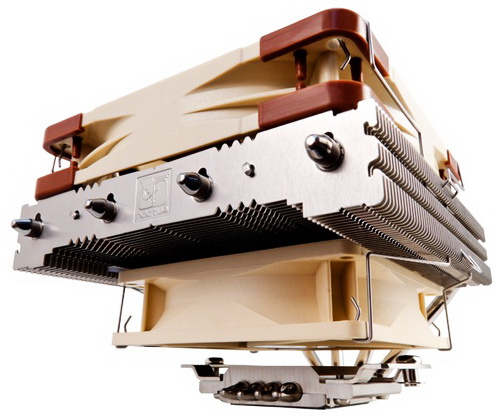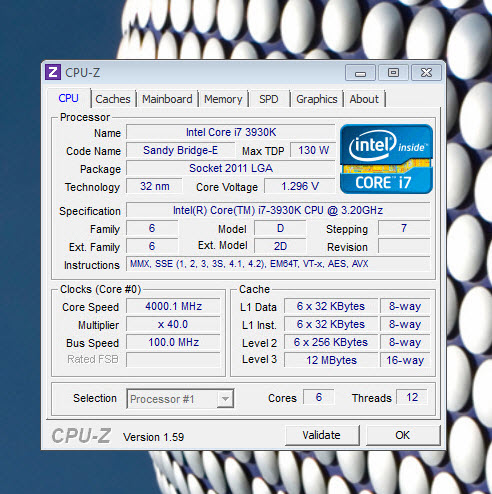INTRODUCTION

Strangely enough although the latest LGA2011 Sandy Bridge CPUs are the hottest thing currently, at least in terms of processing power there still aren't that many new cooling solutions in the market that support them and since i decided on starting over with a brand new LGA2011 based CPU Cooler database (the old LGA1366 one was way too long) this has proven to be quite the problem. Thankfully aside the huge NH-D14 SE2011 CPU Cooler Noctua has also launched another LGA2011 compatible CPU Cooler the latest low-profile NH-L12 which although targeted towards HTPC users and not hardcore overclockers and enthusiasts still it carries quite a punch for its size as you will see later on.
Designed in Austria, Noctua's premium cooling components are internationally renowned for their superb quietness, exceptional performance and thoroughgoing quality. Having received more than 1000 awards and recommendations from leading hardware websites and magazines, Noctua's fans and heatsinks are chosen by more than a hundred thousand satisfied customers around the globe. Noctua comes from a cooperation of the Austrian Rascom Computerdistribution Ges.m.b.H. with the Taiwanese cooling specialist Kolink International Corporation, pooling more than ten years of experience in the development, manufacturing and marketing of high-end cooling components. Established in 2005, Noctua took the international silent enthusiasts' hearts by storm and quickly developed into one of the most acclaimed suppliers of premium quality quiet cooling products. Today, Noctua is present in more than 30 countries across the globe and working with several hundred sales partners. Chosen by noise conscious PC users, system integrators and industry clients alike, Noctua has become synonymous with impeccable quality, excellent customer service and class leading quiet cooling performance.
Some of you may remember the large NH-C14 low profile high performance CPU Cooler again manufactured by Noctua which i had the chance to test over a year ago with quite impressive results (very close to the NH-D14). Well the NH-C14 is still the best low-profile CPU Cooler i have tested to date but aside rather expensive it's also quite large so it may not be the most ideal solution for small HTPC cases. With the NH-L12 Noctua is focusing on that exact segment of the market and although they still have the very good NH-C12SE14 the NH-L12 is not only better but also smaller. Still our overclocked Core i7 3930k CPU is pretty hot under heavy load so i was quite interested to see how well the NH-L12 would do from the very first to the very last test.
SPECIFICATIONS AND FEATURES


PACKAGING AND CONTENTS
At the right side we see the features of the unit along with the rear of the latest NF-F12 120mm PWM fan by Noctua used as background image.
The same features list is also present at the front, this time however there's a round sticker stating the height of the NH-L12 (66mm) and the heatpipes at the rear of the unit are used as background image.
Detailed specification lists for all the parts of the NH-L12 (fans and heatsink) are present at the left side of the box.
A short product description is placed at the rear in 8 languages.
The features of the NH-L12 are explained in-depth at the top.
As usual with Noctua products both the bundle and the cooler are placed inside formed cardboard pieces.
The bundle is nothing short of rich and included the NH-L12 CPU Cooler (with both fans pre-mounted), 3 installation manuals, a large screwdriver, Noctua case badge, NT-H1 thermal paste tube, 4pin fan extension cable, low noise adapters, Y-split fan adapter and mounting hardware for Intel LGA2011/1366/1156/1155/775 and AMD FM1/AM3+/AM3/AM2+/AM2 CPUs.
THE NH-L12
Remember the round sticker on the box stating that the unit is just 66mm in height? Well it's somewhat vague (it does mention single-fan mode) so although the heatsink itself is indeed 66mm in height with the NF-F12 fan installed it increases to 93mm.
The top NF-F12 120mm PWM fan is the latest addition in the Noctua line of products and comes with integrated anti-vibration rubber pads on all four corners.
As you can see the NH-L12 comes with almost the same convenient fan clips as the NH-D14 SE2011.
Once you remove the top fan you will see two holes which are used to mount the unit onto the mainboard with the help of the bundled screwdriver.
The heatsink has a grand total of 66 aluminum fins and measures 150mm in depth (long).
In width the NH-L12 measures a total of 128mm.
Noctua has engraved their logo on the front aluminum fin.
According to Noctua thanks to their brand new Focus Flow system the latest NF-F12 120mm PWM fan produces the highest static pressure of all their models and so it's ideal for use with CPU Coolers. That aside the NF-F12 has a top rotational speed of 1500RPM and produces up to 55CFM of airflow at just 22.4dBA.
The NF-B9 90mm PWM fan is placed in push & pull configuration at the bottom of the NH-L1 and although quite old its top rotational speed of 1600RPM allows it to push 37.8CFM of air at 17.6dBA.
There are a total of four 6mm nickel plated copper heatpipes on the NH-L12.
The base of the cooler features a mirror-like finish and is quite even from side to side.
TEST BED


TESTING METHODOLOGY
I always take things quite seriously when it comes to work so just like with the previous LGA1366 database we will not be testing each CPU Cooler on its own and with different ambient temperature levels so we can actually have yet another valid CPU Cooler database. Testing a CPU Cooler automatically means that you need to know where it stands against the immediate competition and to accomplish that we have spent both money and time through the years, something that i plan to continue to do so in order to get the most accurate results for the end users who read these lines. Every CPU cooler in this database will be tested with its bundled 140mm/120mm/92mm/80mm fans while working at 100% of their speeds for all the temperature tests. CPU Coolers that do not come bundled with a fan/s are measured using a Noctua fan (size dependent on the model) to test for the temperature tests but due to the lack of a stock fan we will not be measuring their dBA levels. For the dBA test every cooler in the database was measured both while on idle mode or with the fan controller in the minimum setting and while on extreme load or with the fan controller all the way to the highest possible setting. PWM fans do that or their own without our intervention. Every single test takes place in a temperature controlled room of 23 degrees Celsius Ambient Temp with the help of two AC units placed diagonally inside the room. The Arctic Silver 5 thermal paste is used with every CPU Cooler in our latest LGA2011 database (although initially this was not the plan we had to change things to get the most accurate results). Finally it's very important to point out that just because a CPU Cooler is better than another when tested with our test rig CPU, the Intel Core i7-3930k that does not necessarily mean that the same performance differences will apply 100% for other CPU models and in other situations (such as different ambient temps and system configurations).
To successfully record the load temperatures we use the latest OCCT application for around 6-10 minutes to push the processor to its limits and after that is done and the temperatures are recorded we wait for about 10-20 minutes for the CPU to cool down and record the idle temperatures. This is done to allow time for the thermal conductive material to achieve the optimal performance level. Same procedure is then repeated with the Passmark BurnIn Test as a failsafe just in case the OCCT results are wrong. This procedure takes a lot more time than the usual peltier/thermometer tests chosen by others but this way not only can we deliver
real world results to our readers based on real CPUs but we can also triple check the results using a variety of programs. Last but not least the temperatures were recorded using both the latest versions of AIDA64 and RealTemp while the noise level test is performed by using a high precision ExTech Decibel Meter placed about 10-15cm above the CPU Cooler. Still although the same testing procedure applies to all units do take into consideration that unlike the official numbers which are measured in special noise isolated labs with just the fans here we also have both the rest of the cooler and the rest of the system (although all system fans are turned off when recording noise levels).
TEST RESULTS


CONCLUSION

If you don't have a limited budget and you are looking for the best possible low-profile CPU Cooler currently in the market (with low noise levels) then the NH-C14 launched over a year ago by Noctua is still the best and a better overall choice than even the latest NH-L12 we tested today. On the other hand the NH-L12 is indeed smaller, costs less and performs extremely well (for a low-profile CPU Cooler) since even under heavy load it managed to keep the temperature of our overclocked Core i7 3930k in very acceptable levels. Still although i really doubt people will use that kind of CPU for HTPC use even if they do they can skip the overclocking part to ensure low temperatures (especially during hot days) although watching a movie or playing a game is nowhere close to stressing a CPU using our methodology.
Noctua is amongst the very few companies that focus not only in the best possible performance but also the highest possible build quality and that's why their solutions are usually more expensive than others. The pricing of the NH-L12 however is actually quite aggressive and so it currently retails for around USD55 inside the USA and 60Euros inside the EU. Certainly that amount of money may seem as a bit high to some people but let's face it, most people will opt for a low level after market CPU Cooler with slightly better performance and lower noise levels than the stock cooler so yes the NH-L12 is not ment for everyone out there. However if you want a medium size low-profile CPU Cooler with very good cooling efficiency and low noise levels then the NH-L12 might just be what you're looking for and that's also why it gets our Golden award.

PROS
- Build Quality
- Performance
- Dual Fan Solution (Push&Pull)
- Low-Profile
- Low Noise Levels
- Size (Compared To The NH-C14)
- Price (For Some)
CONS
- Not the Best Cooling Efficiency (The NH-C14 Is Still At The Top)

 O-Sense
O-Sense

























.png)

